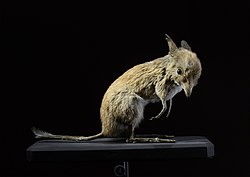Pig-footed bandicoot
| Pig-footed bandicoot | |
|---|---|
 |
|
| Specimen at Grande galerie de l'évolution | |
| Scientific classification | |
| Kingdom: | Animalia |
| Phylum: | Chordata |
| Class: | Mammalia |
| Infraclass: | Marsupialia |
| Order: | Peramelemorphia |
| Family: |
†Chaeropodidae Gill, 1872 |
| Genus: |
†Chaeropus Ogilby, 1838 |
| Species: | †C. ecaudatus |
| Binomial name | |
|
Chaeropus ecaudatus (Ogilby, 1838) |
|
 |
|
| Historic pig-footed bandicoot range in orange | |
The pig-footed bandicoot (Chaeropus ecaudatus) was a small marsupial of the arid and semi-arid plains of Australia. The distribution range of the species was later reduced to an inland desert region, where it was last recorded in the 1950s; it is now presumed to be extinct.
This species was previously placed in the family Peramelidae, along with the bilbies, as the subfamily Chaeropodinae by McKenna and Bell (1997). However, its form is quite distinct from the Peramelidae and bilbies, and recent molecular evidence supports this distinction. It is believed to be the sister group of the rest of the Peramelmorphia and has been assigned to its own family Chaeropodidae.
The pig-footed bandicoot had a body size of 23–26 cm and a 10–15 cm long tail. In form, it was almost bilby-like on first sight, having long, slender limbs, large, pointed ears, and a long tail. On closer examination, however, it became apparent that the pig-footed bandicoot was very unusual for a marsupial. The forefeet had two functional toes with hooves, rather similar to a pig or deer; this is possibly due to juveniles being deposited in the pouch through external stalks, thus relieving them of using the forelimbs while as joeys. The hind feet had an enlarged fourth toe with a heavy claw shaped like a tiny horse's hoof, with the other toes being vestigial:only the fused second and third toes being useful, and that not for locomotion but for grooming.
It had a broad head, and a long yet slender snout. Its fur was coarse and straight, but not spiny. In color it varied from grizzled grey through fawn to orange-brown, the belly and underparts were white with the fur on the ears being of chestnut color.
This species had five pairs of upper and three pairs of lower incision teeth. The females of the species had eight nipples and the opening of the pouch was faced backwards, not forwards as is the case with kangaroos.
The pig-footed bandicoot was native to western New South Wales and Victoria, the southern part of the Northern Territory as well as South Australia and Western Australia. It inhabited a wide range of habitat types: from grassy woodland and grassland plains to the spinifex country and arid flats of central Australia. Despite its wide range, the species had a sparse distribution and was never abundant.
...
Wikipedia

